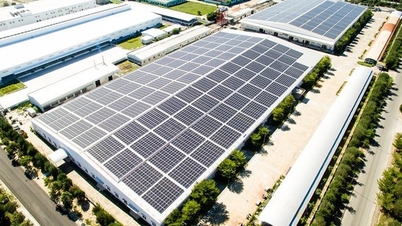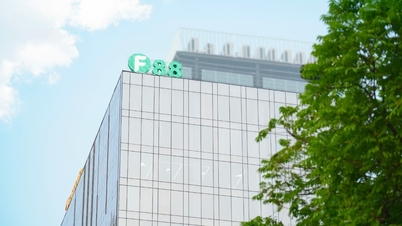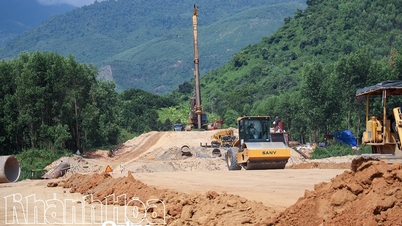Resolution 68 for the first time affirms the role of financial leasing as an important medium and long-term capital solution for the private economic sector. This is considered an opportunity to "awaken" a sector that has long been neglected or not properly understood.
VietNamNet reporter had an interview with Mr. Pham Xuan Hoe, General Secretary of Vietnam Financial Leasing Association, about the current situation, opportunities and solutions to develop this market.
“Pressure relief valve” for the banking system
- Resolution 68 for the first time includes the content of perfecting the legal corridor for financial leasing activities. In your opinion, what new opportunities does this open up for the market?
Mr. Pham Xuan Hoe : This is a real turning point. For the first time, the Central Government has placed financial leasing on par with other strategic credit instruments - from green credit, credit guarantees, small and medium-sized enterprise (SME) support funds, to new capital calling models.
Resolution 68 not only affirms the role of the private economy but also requires the completion of the legal corridor, the expansion of the list of leased assets, and the creation of conditions for cooperation between financial institutions. This is especially important for small and medium enterprises and business households, which are often "blocked" at the door of long-term capital from banks.
If the policy is specified and implemented synchronously, financial leasing will become a "pressure relief valve" for the commercial banking system, contributing to reducing medium and long-term capital pressure for the economy.

- But currently, financial leasing debt only accounts for about 0.28% of total credit debt in the whole economy, the penetration rate into businesses is still very low. What is the main reason, sir?
There are three main reasons.
Firstly , the number of financial leasing companies is too small, currently there are only 9 companies (8 operating, 1 restructuring), while international practice is that this number is usually 10 times the number of commercial banks. This number only meets about 1.5% of market demand.
Second , long-standing policy thinking has "framed" financial leasing into the same management framework as deposit-taking banks, applying the same standards and procedures, eliminating flexibility.
Third , social awareness and even some management agencies on financial leasing are still limited, leading to this service not being exploited to its full potential. As a result, the total outstanding debt of the industry is currently only about 47,000 billion VND, too small compared to the potential of nearly 1 million enterprises and 5.2 million business households.
- You once mentioned “locking” financial leasing into the same framework as commercial banks. So what are the consequences of this approach and what needs to change so that financial leasing can develop in its true nature?
By applying the same management mechanism as commercial banks, we inadvertently take away the biggest advantage of financial leasing: the ability to accept higher risks, make faster decisions and design more flexible products for small and medium enterprises. Regulations on governance, licensing, reporting, asset handling... currently do not clearly distinguish the "non-deposit" nature of financial leasing, causing increased compliance costs, cumbersome procedures, and a narrow product portfolio.
To change, it is necessary to build a separate law or a separate chapter in the Law on Non-Depository Lending Institutions; apply risk management standards separate from banks; expand the list of leased assets, including intangible assets such as software, copyrights, and exploitation rights.
Can reach 100-150 financial leasing companies in the next 5 years
- The Law on Credit Institutions 2024 and Circular 26/2024/TT-NHNN have many new points that are considered more open. But why are many contents such as electronic financial leasing approval or developing banking consulting services still not widely implemented?
The biggest reason is that the technology infrastructure and internal processes of companies are not ready. For example, electronic approval of up to 500 million VND has not been implemented because the information technology architecture has not met the requirements, while the ceiling of 500 million is too low to be attractive.
With banking consulting services or service fees, many units wait for specific instructions or do not immediately see market demand. In addition, the requirement to report customers with outstanding debt of 0.5% or more of equity creates many procedures, even making customers reluctant to access the service.
- In many countries, the number of financial leasing companies is 10 times the number of commercial banks, while Vietnam only has 9. In your opinion, what is a feasible solution to rapidly increase the number of companies in the next few years?
First of all, it is necessary to simplify licensing conditions and encourage the establishment of new companies from both domestic and FDI sources. The legal capital of 150 billion VND is not too big a barrier; the problem is that the current process is still complicated. Large corporations, including non-financial ones, should be allowed to establish general finance companies with financial leasing functions.
In parallel, the development of the Law on Financial Leasing or the Law on Non-Deposit Lending Institutions will create stable and clear rules of the game, attracting investors. If done well, we can reach 100-150 companies in the next 5 years, bringing the SME penetration rate to 10-15%.
- Besides legal, how do social barriers and business habits of Vietnamese enterprises affect market development? What needs to be done to change this perception and habit?
Business culture in Vietnam still heavily focuses on "ownership" of assets, causing many businesses to overlook the benefits of financial leasing in terms of capital savings and technological innovation. Even tax and property registration authorities are not familiar with this form, leading to slow or incorrect processing of documents.
To change, a strong communication campaign is needed, in coordination with industry associations, banks, and regulatory agencies to introduce the benefits and processes of financial leasing. At the same time, there must be "easy to understand - easy to access" product packages for SMEs, such as leasing production lines, medical equipment, means of transport with minimal procedures and full service packages.
Finance leasing - figures and international comparison Vietnam: Outstanding debt of about 47,000 billion VND (0.28% of total outstanding credit); 9 companies are operating. Germany: Financial leasing accounts for approximately 16% of total corporate credit. US: 22% of total corporate asset value is formed from financial leasing. China: 18% of enterprises have financial leasing contracts. Japan, Korea, Taiwan (China): 70-80% of SMEs use financial leasing for machinery and equipment. |
Source: https://vietnamnet.vn/nen-cho-phep-cac-tap-doan-lon-thanh-lap-cong-ty-cho-thue-tai-chinh-2431902.html


![[Photo] Students of Binh Minh Primary School enjoy the full moon festival, receiving the joys of childhood](https://vphoto.vietnam.vn/thumb/1200x675/vietnam/resource/IMAGE/2025/10/3/8cf8abef22fe4471be400a818912cb85)




![[Photo] Prime Minister Pham Minh Chinh chairs meeting to deploy overcoming consequences of storm No. 10](https://vphoto.vietnam.vn/thumb/1200x675/vietnam/resource/IMAGE/2025/10/3/544f420dcc844463898fcbef46247d16)






























































































Comment (0)